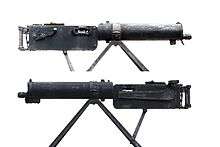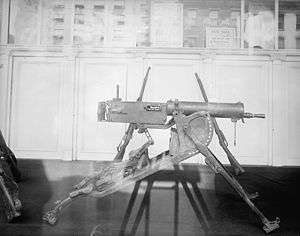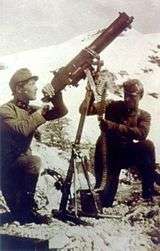MG 08
| Maschinengewehr 08 | |
|---|---|
|
MG 08 on a sledge mount w/muzzle booster fitted | |
| Type | Heavy machine gun |
| Place of origin | German Empire |
| Service history | |
| In service |
1908–1945 (Germany) 1911–1960s (China) |
| Used by | See Users |
| Wars |
Xinhai Revolution World War I Finnish Civil War Polish–Soviet War Chinese Civil War World War II Second Sino-Japanese War Korean War First Indochina War Vietnam War |
| Production history | |
| Manufacturer |
Deutsche Waffen und Munitionsfabriken (DWM) Spandau and Erfurt arsenals Hanyang Arsenal |
| Number built | 173,000+ |
| Variants |
lMG 08 (aircraft) MG 08/15 (lightened,infantry) LMG 08/15 (aircraft) HMG Type 24 (infantry,Chinese variant) |
| Specifications | |
| Weight |
Total 69 kg (152.1 lb) with water, 65 kg (143.3 lb) without water 26.5 kg (58.4 lb) gun body, 4 kg (8.8 lb) of water, 38.5 kg (84.9 lb) tripod |
| Length | 1,175 mm (46.3 in) |
| Barrel length | 721 mm (28.4 in) |
| Crew | four man crew |
|
| |
| Cartridge |
8×57mm IS 7.65×53mm 13×92mm TuF (TuF variant) |
| Action | Short recoil, Toggle locked |
| Rate of fire | 500-600 rounds/min |
| Muzzle velocity | 900 m/s (2,953 ft/s) |
| Effective firing range | 2,000 m (2,187 yd) |
| Maximum firing range | 3,500 m (3,828 yd) |
| Feed system | 250-round fabric belt |
The Maschinengewehr 08, or MG 08, was the German Army's standard machine gun in World War I and is an adaptation of Hiram S. Maxim's original 1884 Maxim gun. It was produced in a number of variants during the war. The MG 08 served during World War II as a heavy machine gun in many German infantry divisions, although by the end of the war it had mostly been relegated to second-rate fortress units.
The Maschinengewehr 08 (or MG 08)—so-named after 1908, its year of adoption—was a development of the license made Maschinengewehr 01. The firing rate depends on the lock assembly used and averages 500 rounds per minute for the Schloss 08 and 600 rounds per minute for the Schloss 16. The gun used 250-round fabric belts of 7.92×57mm ammunition, although sustained firing would lead to overheating; it was water-cooled, using a jacket around the barrel that held approximately one gallon of water. Using a separate attachment sight with range calculator for indirect fire, the MG 08 could be operated from cover. Additional telescopic sights were also developed and used in quantity during the war.
The MG 08, like the Maxim gun, operated on the basis of short barrel recoil and a toggle lock; once cocked and fired the MG 08 would continue firing rounds until the trigger was released (or until all available ammunition was expended). Its practical range was estimated at some 2,000 metres (2,200 yd) up to an extreme range of 3,600 metres (3,900 yd). The MG 08 was mounted on a sled mount (German: Schlittenlafette) that was ferried between locations either on carts or else carried above men's shoulders in the manner of a stretcher.
Pre-war production was by Deutsche Waffen und Munitionsfabriken (DWM) in Berlin and the government arsenal at Spandau (so that the gun was often referred to as a Spandau MG 08). When the war began in August 1914, approximately 12,000 MG 08s were available to battlefield units; production, at numerous factories, was however markedly ramped up during wartime. In 1914, some 200 MG 08s were produced each month; by 1916—once the weapon had established itself as the pre-eminent defensive battlefield weapon—the number had increased to 3,000; and a year later to 14,400 per month.
MG 08/15


A lightened and thus more portable version — by "stepping-down" the upper rear and lower forward corners of the original MG 08's rectangular-outline receiver and breech assembly, and reducing the cooling jacket's diameter to 92.5 millimeters — was tested as a prototype in 1915 by a team of weapon designers under the direction of an Oberst Friedrich von Merkatz—the MG 08/15. The MG 08/15 had been designed to be manned by four trained infantrymen spread on the ground around the gun and in the prone position. To accomplish that purpose, the MG 08/15 featured a short bipod rather than a heavy four legged sled mount, plus a wooden gunstock and a pistol grip. At 18 kg, the MG 08/15 was lighter and less cumbersome than the standard MG 08, since the MG 08/15 had been designed to provide increased mobility of infantry automatic fire. It nevertheless remained a bulky water-cooled weapon that was quite demanding on the quality and training of its crews. Accurate fire was difficult to achieve and usually in short bursts only. It was first introduced in battle during the French "Chemin des Dames" offensive in April 1917, where it contributed to the very high casualty count among the French assailants. Its deployment in increasingly large numbers with all front line infantry regiments continued in 1917 and during the German offensives of the spring and summer of 1918. The MG 08/15 became, by far, the most common German machine gun deployed in World War I (Dolf Goldsmith, 1989) since it reached a full allocation of six guns per company or 72 guns per regiment in 1918. By that time, there were four times as many MG 08/15 light machine guns than heavy MG 08 machine guns in each infantry regiment. To attain this goal, about 130,000 MG 08/15 had to be manufactured during World War I, most of them by the Spandau and Erfurt government arsenals.
An air-cooled and thus water-free and lighter version of the MG 08/15, designated as the MG 08/18, was battlefield tested in small numbers during the last months of the war. The MG 08/18's barrel was heavier and it could not be quick-changed, thus overheating was inevitably a problem.
The word 08/15 lives on as an idiom in colloquial German, 08/15 (pronounced Null-acht-fünfzehn), being used even today as an adjective to denote something totally ordinary and lacking in originality or specialness. However, this is one of several possible origins of the idiom.
Aircraft versions

A lightened air-cooled version of the original water-cooled rectangular pattern-receiver MG 08 infantry automatic ordnance, the lMG 08, was developed by the Spandau arsenal as a rigidly mounted aircraft machine gun and went into production in 1915, in single-gun mounts, for use on the E.I through the E.III production versions of the Fokker Eindecker. A lower case letter "L" beginning the prefix meant luftgekühlt (air-cooled) rather than Luft (air).[1] The lMG 08s were later used in pairs by the time of the introduction of the Fokker D.III and Albatros D.I biplane fighters in 1916, as fixed and synchronized cowling guns firing through the propeller. The Parabellum MG14 built by DWM was a lighter (22 lbs) and quite different, air-cooled Maxim system gun with a very high rate of fire (900 rounds/min). It was introduced in 1915, and was, but not without serious problems on occasion (as noted by Otto Parschau), prototyped on Parschau's own A.16/15 Fokker A.III "green machine" monoplane with the Fokker Stangensteuerung gun synchronizer, received back with the synchronized Parabellum by Parschau on May 30, 1915[2] and first used in quantity as the synchronized forward-firing armament on the five examples of the Fokker M.5K/MG Eindecker production prototype aircraft, and soon afterwards served as a flexible aircraft observer's gun for rear defense. The initial model of the air-cooled "Spandau" lMG 08 front-firing cowling machine guns had lost the stocks, grips, and bipods of the infantry MG 08s to adapt it to a fixed, forward-firing mount forward of an aircraft's cockpit, with gun synchronization allowing safe firing through a spinning propeller's arc. The 105 mm diameter cylindrical sheet metal water jacket used for the infantry's MG 08, an important support member for the barrel, was initially over-lightened with cooling slots, with fourteen rows of such slots completely surrounding and running the whole length of the jacket's circumferential sheetmetal. These alternated between seven rows of nine "oblong" slots, alternating with seven more intervening rows of eight slots and twin round holes fore and aft of the slots apiece. Because of the important physical reinforcement provided by the cooling jacket on the MG 08 series of guns, the excessive slotting of the initial model of the air-cooled lMG 08 — amounting to slightly over 50% of the total area of the cylindrical cooling jacket's original circumferential sheetmetal — rendered the gun as too fragile, to the point of making it impossible to fit the muzzle booster that the water-cooled infantry MG 08 guns could be fitted with.[3] The later models of lMG 08 air-cooled machine gun variously "tweaked" the amount of slotting of the barrel by reducing the amount of sheet metal removed from it in minor ways through at least two or three trial formats, and eventually in the final versions produced, had the slotting omitted at the extreme ends of the cooling jacket's cylindrical member, with a 13 cm wide area of solid sheet metal at the breech end, and a 5 cm wide solid area at the muzzle end, giving the resultant gun much more rigidity. Also, the lMG 08 retained unchanged the rectangular rear receiver and breech assembly of the water-cooled MG 08 infantry weapon. Later the MG 08's receiver would be lightened by being "stepped down" at its upper rear and lower forward corners as the more refined and lighter weight LMG 08/15 version was developed, using the same airframe mounting geometry as the earlier ordnance to allow interchangeability between the earlier lMG 08 and later LMG 08/15 models, with the still well-perforated cooling jacket reduced to a 92.5 mm diameter. The lMG 08 and lMG 08/15 guns would always be used on fixed-wing aircraft, as fixed forward-aimed synchronized firing ordnance initially in single mounts for Germany's 1915-16 era Fokker Eindecker and Halberstadt D.II "scout" single-seat fighters, and by 1916 in dual mounts, first appearing on the mass-produced examples of Robert Thelen's Albatros D.I and D.II fighters in late 1916, and singly on German "C-class" armed two-seat observation aircraft for synchronized forward-firing armament. The usual ammunition load for fighters was for longer, 500 round belts (one for each gun). A device, occasionally fitted to the rear surface of the later LMG 08/15's receiver backplate, told the pilot how much ammunition was left to fire, and later on a significant upgrade to the gun's aerial usability was the fitting of the Klingstrom device on the right side of the receiver, which allowed the gun to be cocked and loaded with one hand from the cockpit. Various cocking/charging handle styles evolved with a simplified distinctive long handled cocking/charging device finally becoming preferred late in the war.
LMG 08/15's used the 30mm "two hole" ammunition belts of the flexible Parabellum MG14 machine gun rather than the wider "three hole" belts of the MG 08/15 water-cooled infantry weapon. It is possible that these belts were used as they were a bit lighter and less bulky than the wider "three hole" ground gun belts and certainly made for standardization which would have been easier for the armorers and in addition allowed for smaller and lighter "tubes" or "chutes" that guided the empty belts into storage containers in the aircraft after firing. It is a common misconception that the tubes or chutes coming out of the fixed mounted aviation LMG 08/15 fixed guns were for expended cartridge cases; in actuality these attachments were for guiding the empty cartridge belts into a container inside the fuselage of the aircraft so that the belts would not interfere with the operation of the aircraft. As the entire MG 08 Spandau family of German machine guns ejected their empty cartridge cases forward through a round hole in the receiver under the barrel (as can be clearly seen on many videos), these cartridge cases were guided out of the aircraft (except on Martin Kreutzer-designed Fokker biplane fighter aircraft, and the Fokker fighters designed by Kreutzer's successor Reinhold Platz) through tubes from under the barrel to the bottom of the fuselage. With Fokker designed aircraft following the Eindecker, the cartridge cases were ejected without tubes from the receiver hole directly into open trays that guided the tumbling cartridge cases backward and sideways onto the sloped fuselage decking, which then streamed down past the cockpit on either side. These trays are clearly visible in photographs but have rarely been recognized for their purpose. Hermann Göring, who flew both the Fokker Dr.I and Fokker D.VII was obviously so annoyed with the case tumbling out in front of him that he had deflectors made on his aircraft to ensure the empty cartridge cases did not find their way into his cockpit. On photographs of Göring's aircraft these plates, seen only on his aircraft, are very prevalent and have even been recognized in scale models of his aircraft copying his particular planes, but even then most historians have failed to recognize their purpose. Both empty belt guides and trays were attached directly to the machine guns rather than to the aircraft. In the famous film showing Australian officers handling the LMG 08/15's from Baron von Richthofen's crashed triplane, the Fokker type belt tubes/chutes and empty cartridge trays can be clearly seen still attached to the guns.
More than 23,000 examples of the LMG 08/15 and an unknown number of the lMG 08 were produced during World War I.[4]

Anti-tank and anti-aircraft variant
A variant chambered in the same 13.2x92mmSR round as the 13.2 mm (0.520 in) Mauser Anti Tank Rifle was introduced in 1918. Designated MG 18 TuF (German: Tank und Flieger), it was issued in limited numbers late World War I.
Chinese version

Because of the Sino-German alliance, the Germans supplied the Chinese with MG 08s. In 1935, the Chinese began to produce the derivative Type 24 Heavy machine gun.
The Type 24 Heavy machine gun, first introduced to the National Revolutionary Army in 1935, designed to replace the original MG 08. It was the standard heavy machine gun for all Nationalists, Communists, and Warlords from 1935. They were usually made in the Hanyang Arsenal. Like the original MG 08, because of transportation difficulties, the M1917 Browning machine gun and other machine guns slowly replaced the Type 24 for the NRA after the Chinese Civil War. The PM M1910, and the SG-43 Goryunov (or Type 53/57 Machine gun) slowly replaced the Type 24 Heavy machine gun after the Chinese Civil War, but it was kept in service with the PLA, KPA and the NVA until the 1960s during the Vietnam War.
The Type 24 heavy machine gun's tripod resembles the tripod of the MG 08. This gun is not able to be mounted on sledge mounts. When aiming at enemy infantry, it usually comes with a muzzle disk. When used as an anti-aircraft gun, it uses a metal pole to make the tripod higher and usually does not come with a muzzle disk. The gun's receiver is similar to the MG 08's gun body. Like the original MG 08, it needs a crew of four.
The Type 24 heavy machine gun is chambered with the 7.92×57mm Mauser round, the standard Chinese military rifle cartridge of Nationalist China.
After the Chinese Civil War, People's Republic of China militia and reserve units converted a number of Type 24 HMG into the 7.62×54mmR Russian cartridge. They were used for training or as filming prop, and never entered service.
Users

 German Empire
German Empire.svg.png) Nazi Germany
Nazi Germany.svg.png) Austria-Hungary
Austria-Hungary.svg.png) Belgium
Belgium Bulgaria
Bulgaria Lithuania: About 800 MG 08 (7,92 mm sunkusis kulkosvaidis 08 m.) and 520 MG 08/15 (7,92 mm lengvasis kulkosvaidis 08/15 m.). Some MG 08 were modernized for anti-aircraft defense.
Lithuania: About 800 MG 08 (7,92 mm sunkusis kulkosvaidis 08 m.) and 520 MG 08/15 (7,92 mm lengvasis kulkosvaidis 08/15 m.). Some MG 08 were modernized for anti-aircraft defense. Netherlands: Ex-German MG 08s confiscated at the end of WWI entered Dutch service in 1925 in the light anti-aircraft role, with the designation M.25.[5]
Netherlands: Ex-German MG 08s confiscated at the end of WWI entered Dutch service in 1925 in the light anti-aircraft role, with the designation M.25.[5] Republic of Korea
Republic of Korea Republic of China: Made under license as the Type 24 heavy machine gun.
Republic of China: Made under license as the Type 24 heavy machine gun. People's Republic of China: Type 24 chambered in the 7.62×54mmR cartridge.
People's Republic of China: Type 24 chambered in the 7.62×54mmR cartridge. Finland
Finland North Korea: Used Chinese Type 24 during the Korean War.
North Korea: Used Chinese Type 24 during the Korean War. Ottoman Empire
Ottoman Empire Romania
Romania Serbia
Serbia Turkey: Used Turkish War of Independence.
Turkey: Used Turkish War of Independence. Norway
Norway Poland: in 1918-44, up to 5,964 MG 08 (ckm wz.08) and 7,775 MG 08/15 (lkm wz.08/15)[6]
Poland: in 1918-44, up to 5,964 MG 08 (ckm wz.08) and 7,775 MG 08/15 (lkm wz.08/15)[6] North Vietnam: Used Chinese Type 24 during the Vietnam War.
North Vietnam: Used Chinese Type 24 during the Vietnam War. Indonesia: Used Chinese Type 24.
Indonesia: Used Chinese Type 24. Malaysia: Used Chinese Type 24.
Malaysia: Used Chinese Type 24.
See also
Weapons of comparable role, performance and era
- Bergmann MG15 nA Gun
- Kjellman machine gun
- M1917 Browning machine gun
- Russian/Soviet PM M1910 machine gun
- Schwarzlose MG M.07/12
- Skoda M1909 machine gun
- Vickers machine gun
References
- Notes
- ↑ Woodman 1997, pg.2-3
- ↑ vanWyngarden, Greg (2006). Osprey Aircraft of the Aces #73: Early German Aces of World War 1. Botley, Oxford UK & New York City, USA: Osprey Publishing. p. 9. ISBN 978-1-84176-997-4.
- ↑ Woodman 1997, pg.2
- ↑ Woodman 1997, pg.3,5
- ↑ War over Holland - Dutch machineguns
- ↑ (Polish) Andrzej Konstankiewicz, Broń strzelecka Wojska Polskiego 1918-39, MON, Warsaw 1986, ISBN 83-11-07266-3, p. 106, 119
- Bibliography
- Bruce, Robert (1997). Machine Guns of World War I. Windrow and Greene Ltd. ISBN 1-85915-078-0.
- Goldsmith, Dolf L. (1989). The Devil's Paintbrush: Sir Hiram Maxim's Gun. Collector Grade Publications. ISBN 0-88935-282-8.
- Woodman, Harry (1997). Spandau Guns, Windsock Mini-Datafile No.10. Albatros Publications Ltd. ISBN 0-948414-90-1.
External links
| Wikimedia Commons has media related to MG08. |
- 13 mm TuF variant
- MG 08 (French)
| ||||||||||||||||||||||||||||||||||
| ||||||||||||||||||||||||||||||||||||||||||||||

